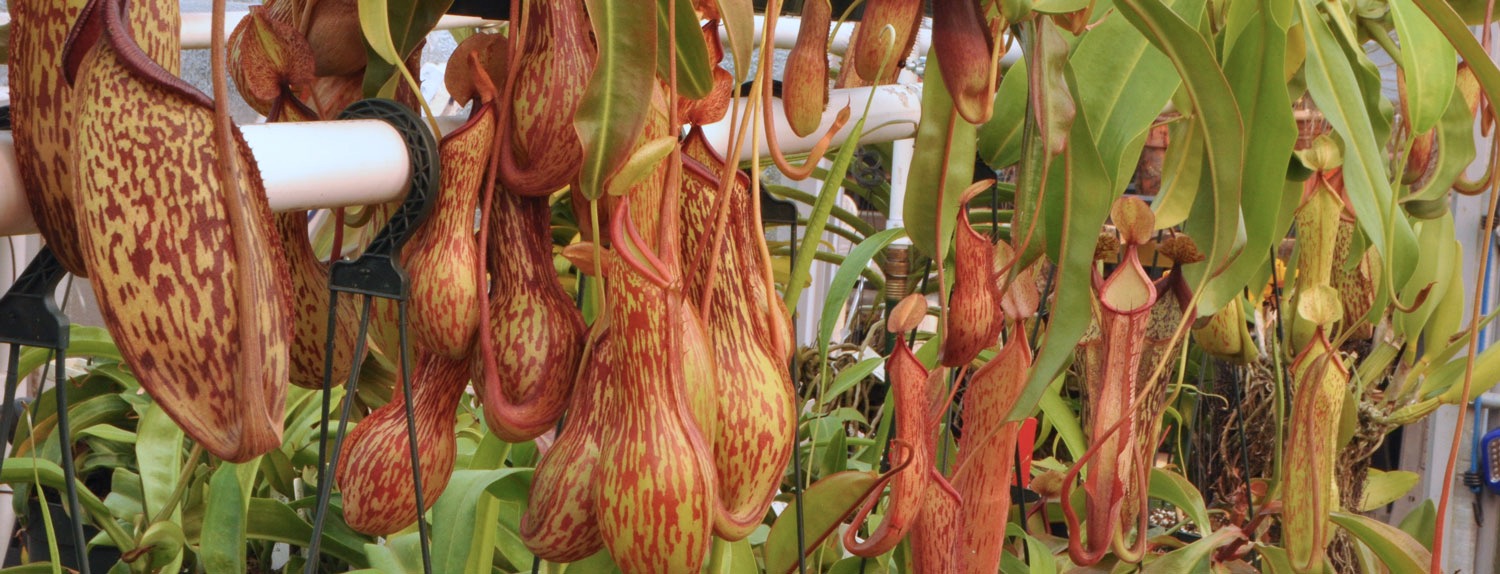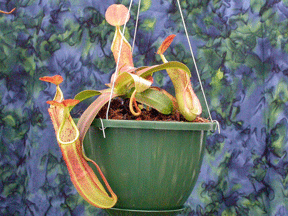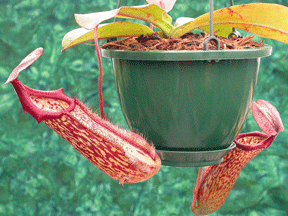Nepenthes Care
Get the straight facts from guys who grow and propagate thousands of carnivorous plants every year.

Nepenthes, commonly known as the Hanging or Asian Pitcher Plants, doubtless are the most ostentatious carnivorous plants next to the Venus flytrap. Among the most flamboyant and colorful of all plants, they are also extremes in carnivory, for Nepenthes are the only plants in the world that can be said to somewhat regularly eat vertebrates in the wild - small lizards, mice, and even rats have been found digesting in their orchid-like traps.
The genus occupies a vast natural range, spanning from Madagascar and the Seychelles, India and Indochina, throughout the innumerable islands of Southeast Asia and through the northeastern cape of Australia. Such a gigantic distribution has shown that Nepenthes, all 170+ species of them, have adopted countless forms, from the squat, ground-hugging detritivores, to tall arcing vines, some with tiny speckled traps like miniature wine glasses, others grown beastly, with sharp hook-lined gullets that drown rodents, and some remarkable species even bear pitchers which serve as roosts for bats!
Fortunately, the vast majority of
Nepenthes are easily grown as houseplants. In fact, some of our most common houseplants originate from similar places that Nepenthes do. Only a small handful of Nepenthes require a carefully-controlled environment, like a grow chamber or ventilated terrarium. But those are expensive to keep and cultivate, so if you are new to growing Nepenthes, start off with one of the many easier species that grow well as a houseplant.
Below are some of the common species and hybrids you might find in cultivation:



Where to Grow
Many common varieties of Nepenthes originate where common houseplants originate, so they will grow spectacularly on sunny windowsills. Unobstructed windowsills facing south, east, or west are appropriate, the main concern being ample sunlight. Humidity is a negligible factor as these plants can acclimate to lower humidity. You may be able to grow Nepenthes outside if you live in a subtropical climate, like San Diego or Miami. Many can take brief overnight chills down to 40°F (4°C), but the day temperature should be in the mid 70s. Always avoid frost.
Sunlight
Provide partial sunlight, several hours of unobstructed, direct sun with bright filtered light during the rest of the day. Avoid full shade. Sunlight is the key element in getting your plant to grow pitchers. The energy provided by photosynthesis is what grows the traps, and sunlight is essential for pitcher production and good color. With proper lighting, many Nepenthes can be grown as regular houseplants.
With proper sunlight, many Nepenthes can be grown as regular houseplants.
The photos below are from our customers!
Artificial Lights
If a sunny window is not possible, use LED shop lights with an output of approximately 2,500 lumens or more. Avoid full-spectrum or so-called plant lights. These lights have red and blue diodes which can strain your eyes and do not significantly contribute to your plant’s overall health any more than shop lights with white diodes. Start with the lights approximately 12 inches above the plant. Monitor your plant and adjust the height of the light source if you are not satisfied with its growth. Use an electrical timer to maintain a 14-hour daylight cycle.
Temperature
Chances are if you’re comfortable in jeans and a t-shirt, your Nepenthes are comfortable, so it’s not necessary to fret about the temperature. They grow well when the day temperature is in the 70s (22°-26°C) with a nighttime drop into the 60s (16°-20°C), common temperatures many houseplants thrive in. Avoid frost and prolonged exposures of temperatures in the 40s (6°-10°C).
Water
Unlike other carnivorous plants,
Nepenthes will tolerate hard water (up to 200 parts per million) with almost no adverse effect. Make sure the water drains through the soil completely, hefting the pot to make sure it's heavy and saturated. Avoid standing water, as this can cause root rot in Nepenthes, and can make them susceptible to pests.
Soil
Use a mix of 1 part dried sphagnum moss and 1 part perlite. Avoid using potting soil and compost, as their nutrient and mineral ingredients can kill carnivorous plants.
Need more information about growing Nepenthes? Watch our volume 3 playlist and monthly videos. Our digital download, The Ultimate Carnivorous Plant Guide for Beginners, is also a fantastic resource if you are new to growing plants. You will learn how various elements – sunlight, water, soil, and humidity – affect plant growth and how to troubleshoot common plant problems. Visit the website to access these resources.
THE ULTIMATE CARNIVOROUS PLANT GUIDE FOR BEGINNERS
In this downloadable ebook, Jacob Farin, co-owner of Sarracenia Northwest, will show you how to think like a professional carnivorous plant grower and keep your first carnivorous plant alive and healthy. You will learn:
- how sunlight and water affect plant growth.
- what type of soil and pots to use.
- if you really need to shelter your plants from snow and ice.
- how to troubleshoot common plant problems.
If you are new to carnivorous plants or have struggled to keep them alive, this ebook is for you. Download your copy today!
